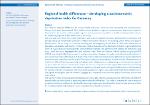Hinweis
Dies ist nicht die aktuellste Version von dieser Publikation. Die aktuellste Version finden Sie unter: https://edoc.rki.de/handle/176904/2657.2
Regional health differences – developing a socioeconomic deprivation index for Germany
Kroll, Lars Eric
Schumann, Maria
Hoebel, Jens
Lampert, Thomas
For Germany, regional differences for various health indicators, which are also associated with socioeconomic factors, have been documented. This article aims to develop a regional socioeconomic deprivation index for Germany that (1) can be used to analyse regional socioeconomic inequalities in health and (2) provides a basis for explaining regional health differences in Germany. The core data stem from the INKAR (indicators and maps on spatial and urban development in Germany and Europe) database compiled by Germany’s Federal Institute for Research on Building, Urban Affairs and Spatial Development. Factor analysis is used for indexing and the weighting of indicators for the three dimensions of education, occupation and income. The German Index of Socioeconomic Deprivation (GISD) is generated at the levels of associations of municipalities, administrative districts and administrative regions for the years 1998, 2003, 2008 and 2012. Aggregate data and individual data from the German Health Update 2014/2015-EHIS (GEDA 2014/2015-EHIS) study are used to analyse associations between the index and selected health indicators. For around two thirds of the causes of death, the German Index of Socioeconomic Deprivation reveals significant socioeconomic inequalities at the level of Germany’s administrative regions. At district level, life expectancy in the bottom fifth of districts presenting the highest levels of deprivation is, depending on the observation period, 1.3 years lower for women and 2.6 years lower for men in comparison to the upper fifth of districts presenting the lowest levels of deprivation. The index can explain 45.5% and 62.2% of regional differences in life expectancy for women and men, respectively. Moreover, the population in regions characterised by high levels of deprivation has significantly higher rates of smokers, engages less frequently in leisure-time physical activities and is more often obese. The German Index of Socioeconomic Deprivation illustrates regional socioeconomic differences at different spatial levels and contributes to explaining regional health differences. This index is intended for use in research as well as by federal and federal state health reporting systems and should enable access to new sources of data for investigating the links between social inequalities and health in Germany.
Dateien zu dieser Publikation
Keine Lizenzangabe

